Wedding singing in call-and-response folk song of Vietnamese people
Across regions of our country, there are many forms of collective singing activities
between men and women: Quan Ho singing, Vi singing, Giam singing, Dam singing, Gheo
singing, Trong Quan singing, Co La singing, Khoan chanty, Ong chanty, Gia Gao chanty,
Cheo Ghe chanty, Cay chanty which are collectively called Call-and-Response Folk Songs.
These can be seen as conversations with the singing that is both direct and very artistic,
interesting and attractive of the old-time workers, most of whom are boys and girls in love.
Entering the singing, the boys and girls can call and respond to each other in many ways:
opening singing, welcoming singing, quiz singing, love-sick singing, blaming singing,
wedding singing, goodbye singing. Each stage has a different style and interesting
characteristics. Understanding these singing stages is essential to get a truly complete and
profound view of the role and value of the call-and-response folk songs in the community
life. Folk songs texts (comprising only the words and notes separated from the context, not
seamlessly arranged according to the singing process), from the research results, will also
be more thoroughly realized, true to the inherent values.
These call-and-response folk songs can be performed at anytime, anywhere, while
working, playing, and in festival. These lyrical songs meet the needs of composing and
enjoying the music of all classes and ages, jobs; therefore, they have the ability to connect
the community strongly. Each song has always fixed elements (singing style, theme,
content. predetermined) and not fixed (singers, listeners, places, times, situations.), that
is why the progress is often unduplicated. As the context of the performance changes, the
verses are also used creatively to create a concordance. No singings are the same. This is
the appeal of the call-and-response folk songs. The verses are both formal and creative.
The voices of the community and the performers are harmoniously combined. In this living
space, everyone feels “living” fully and completelywith their feelings, dreams and
aspirations.
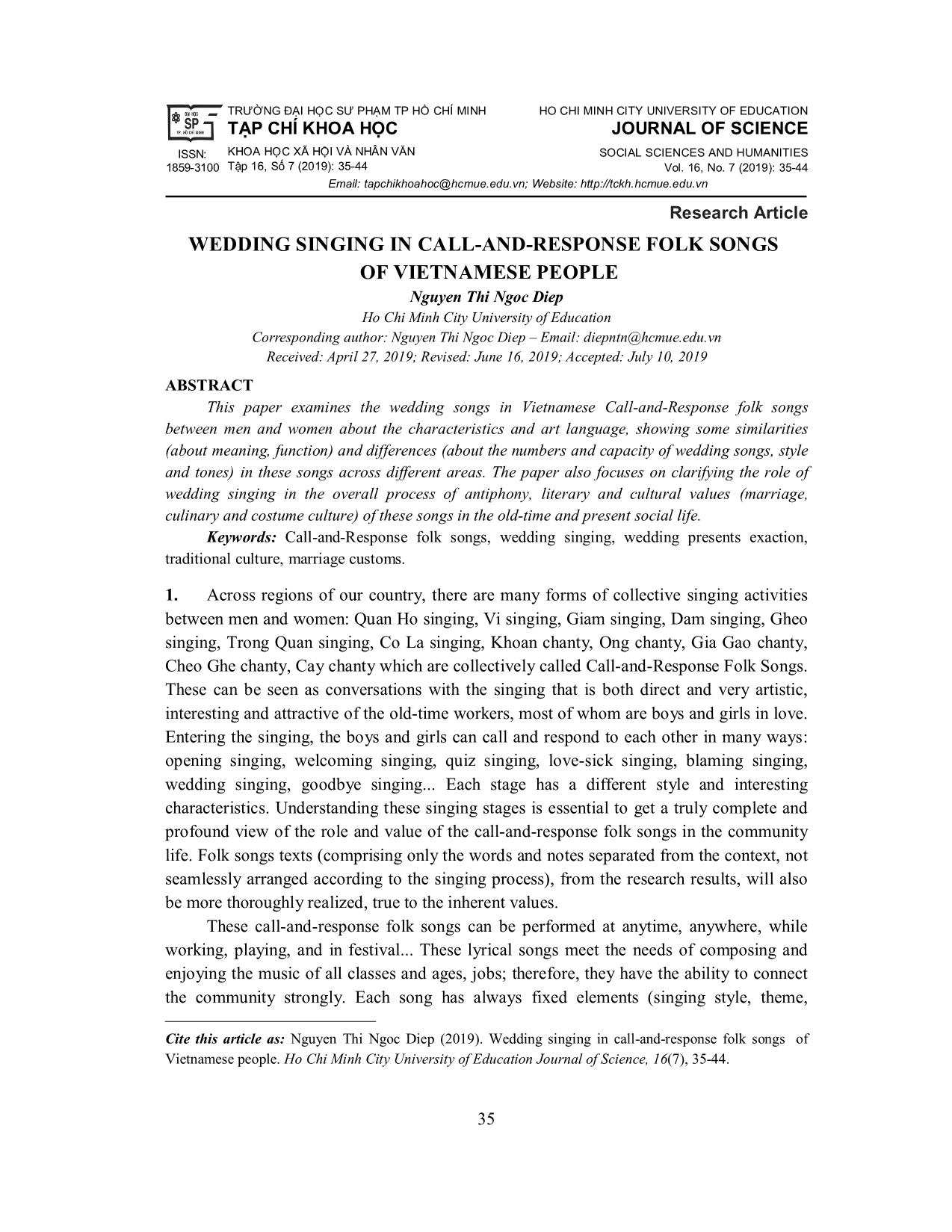
Trang 1
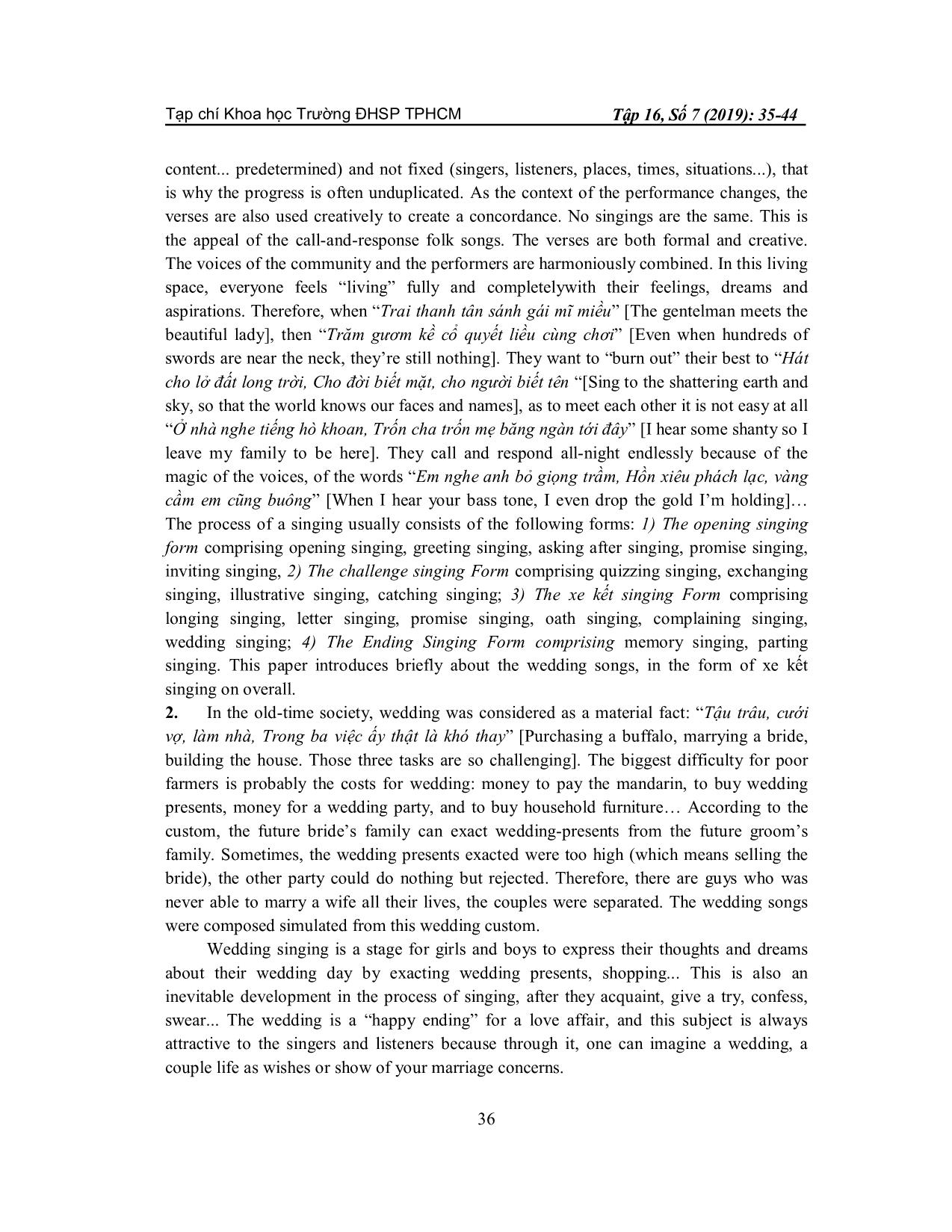
Trang 2
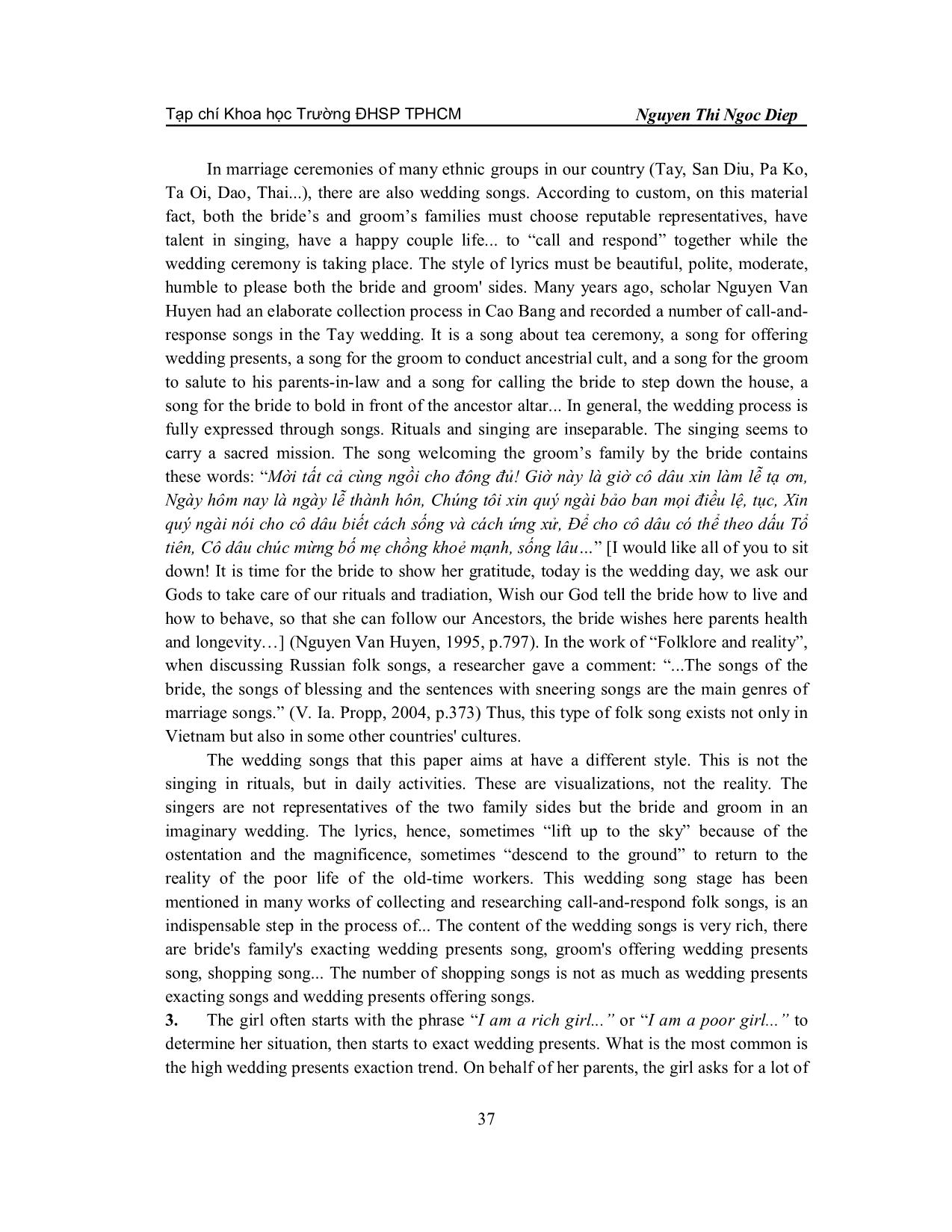
Trang 3
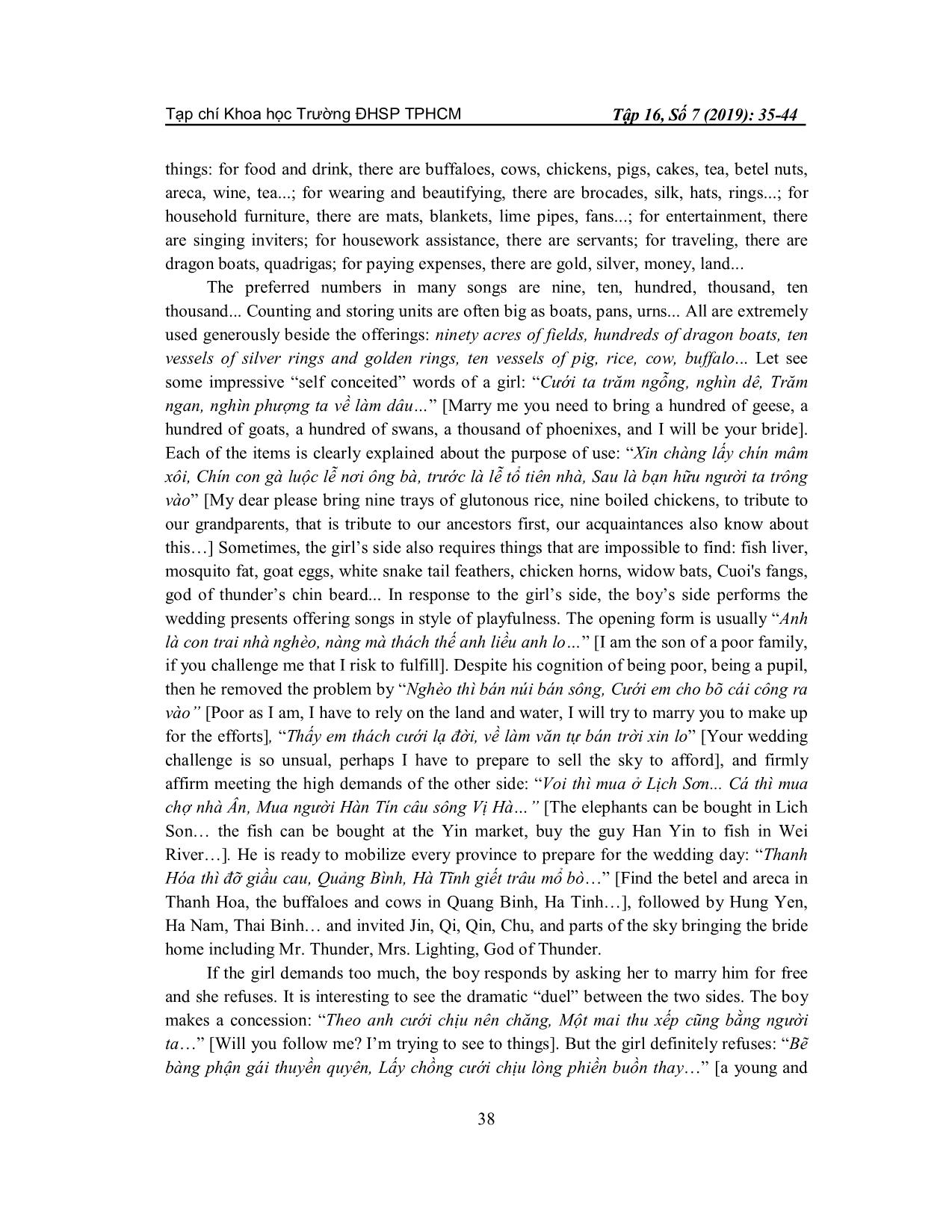
Trang 4
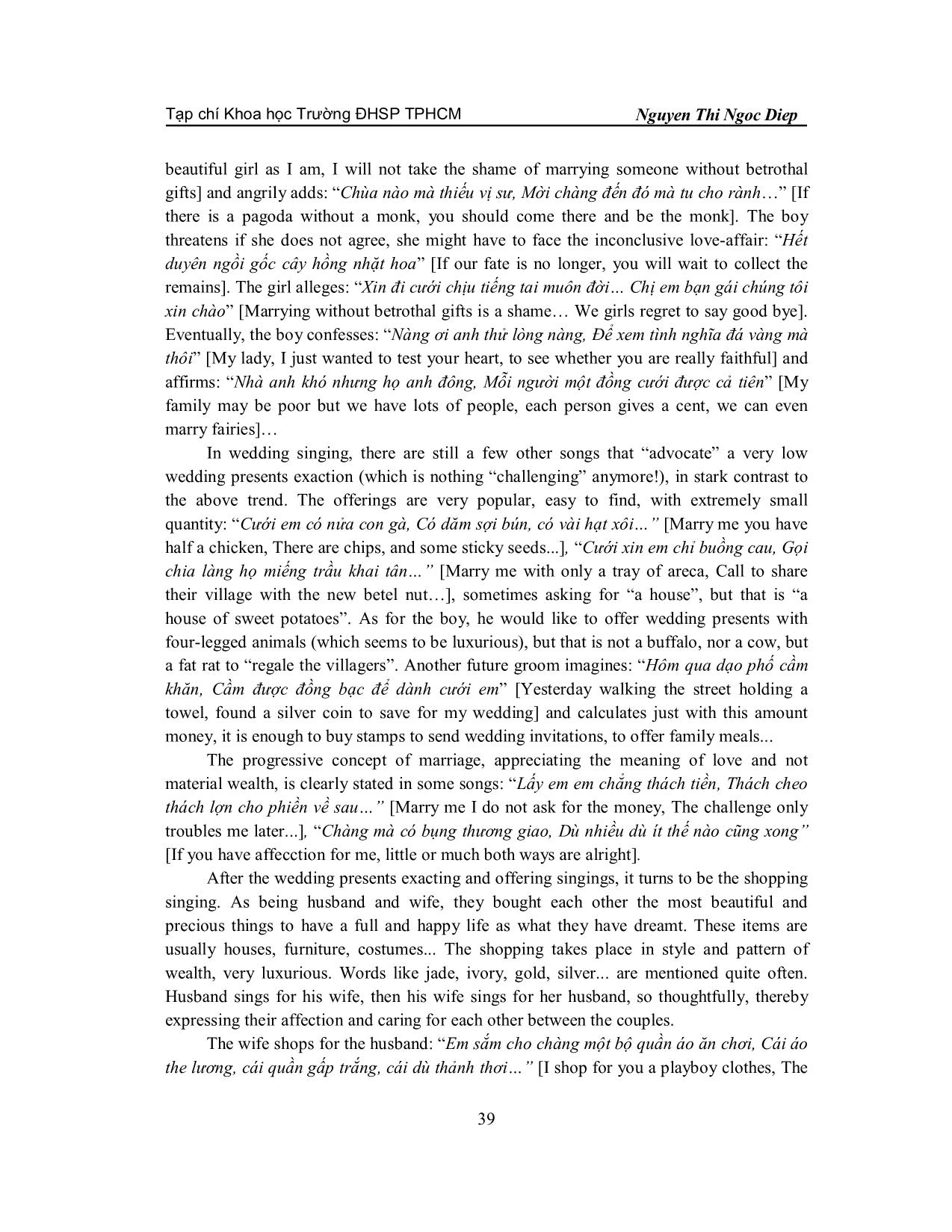
Trang 5

Trang 6
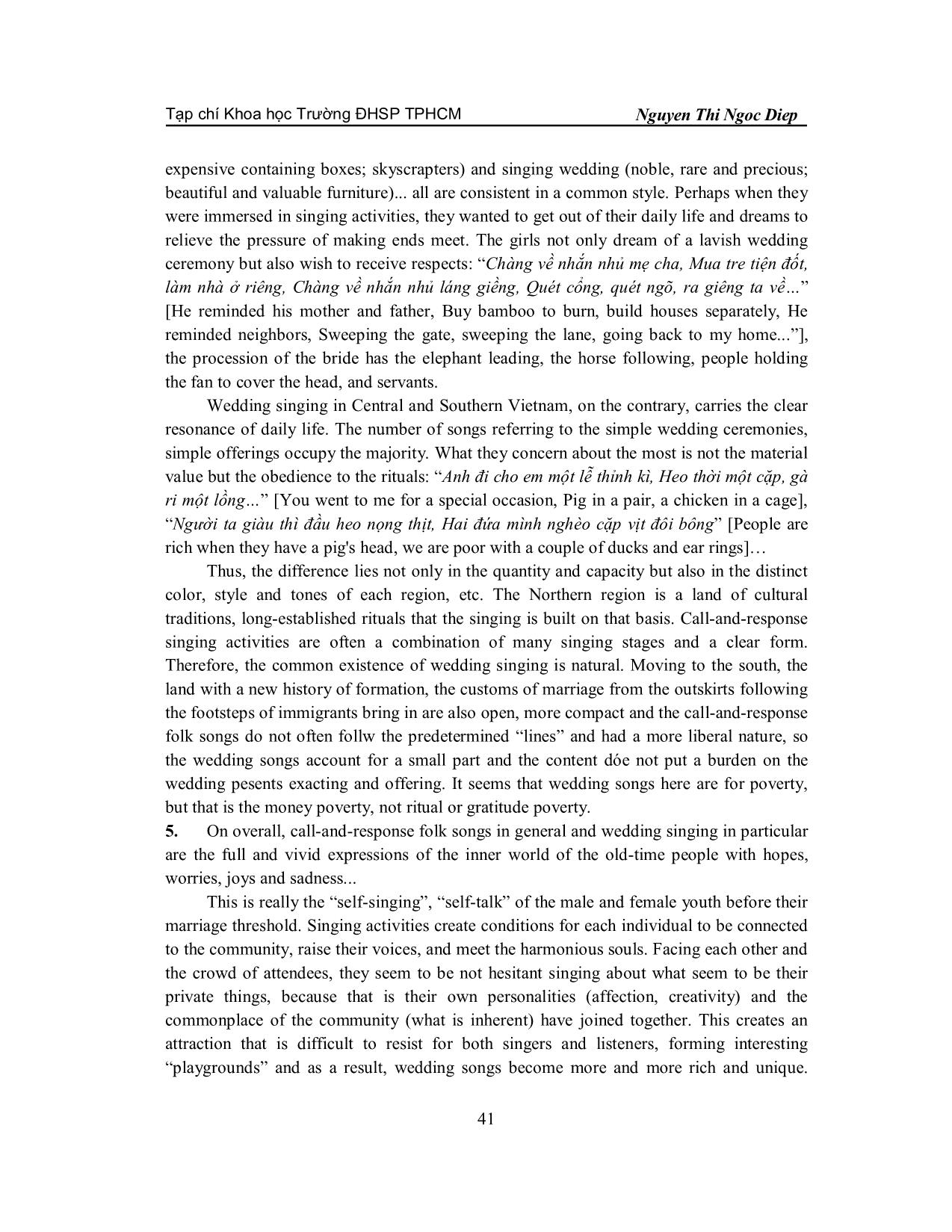
Trang 7
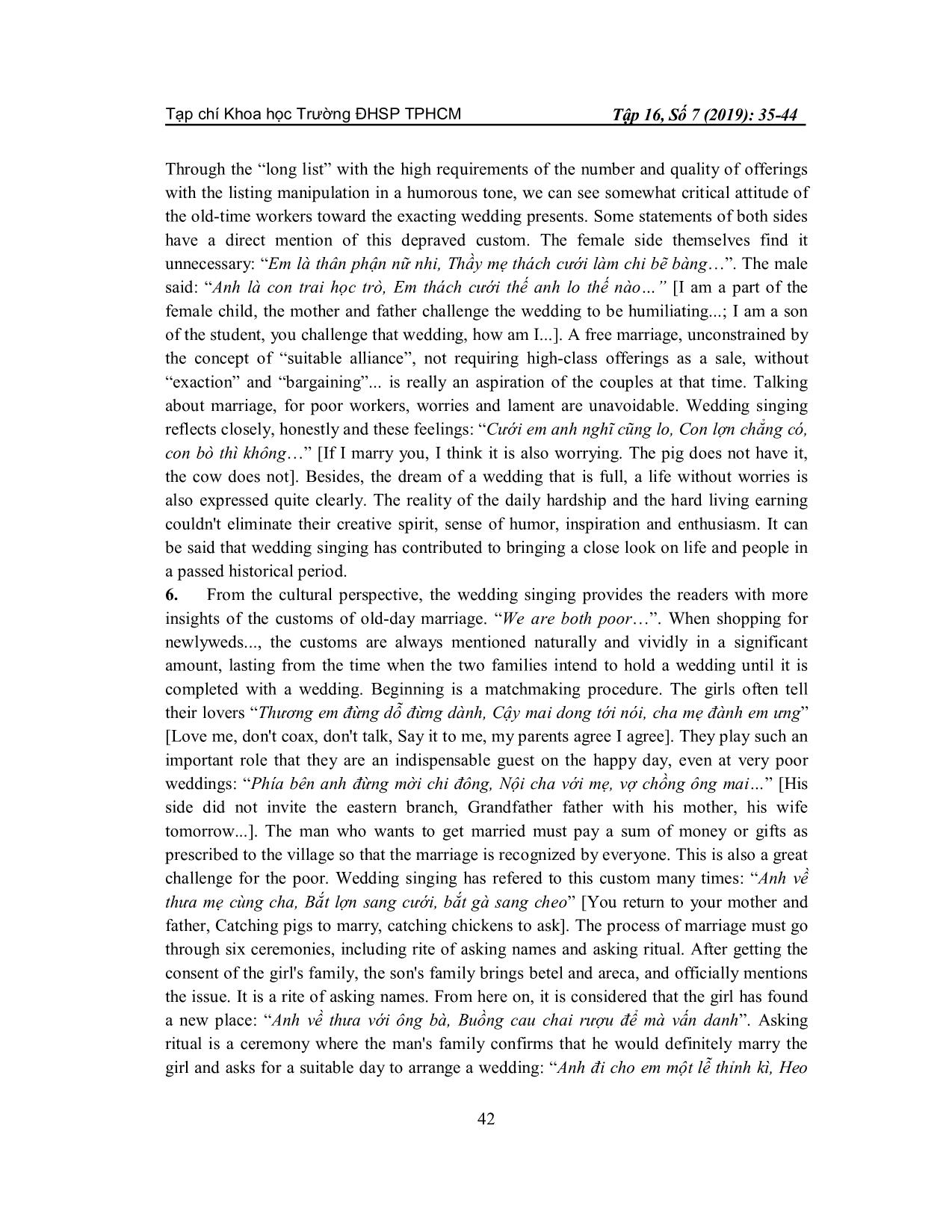
Trang 8
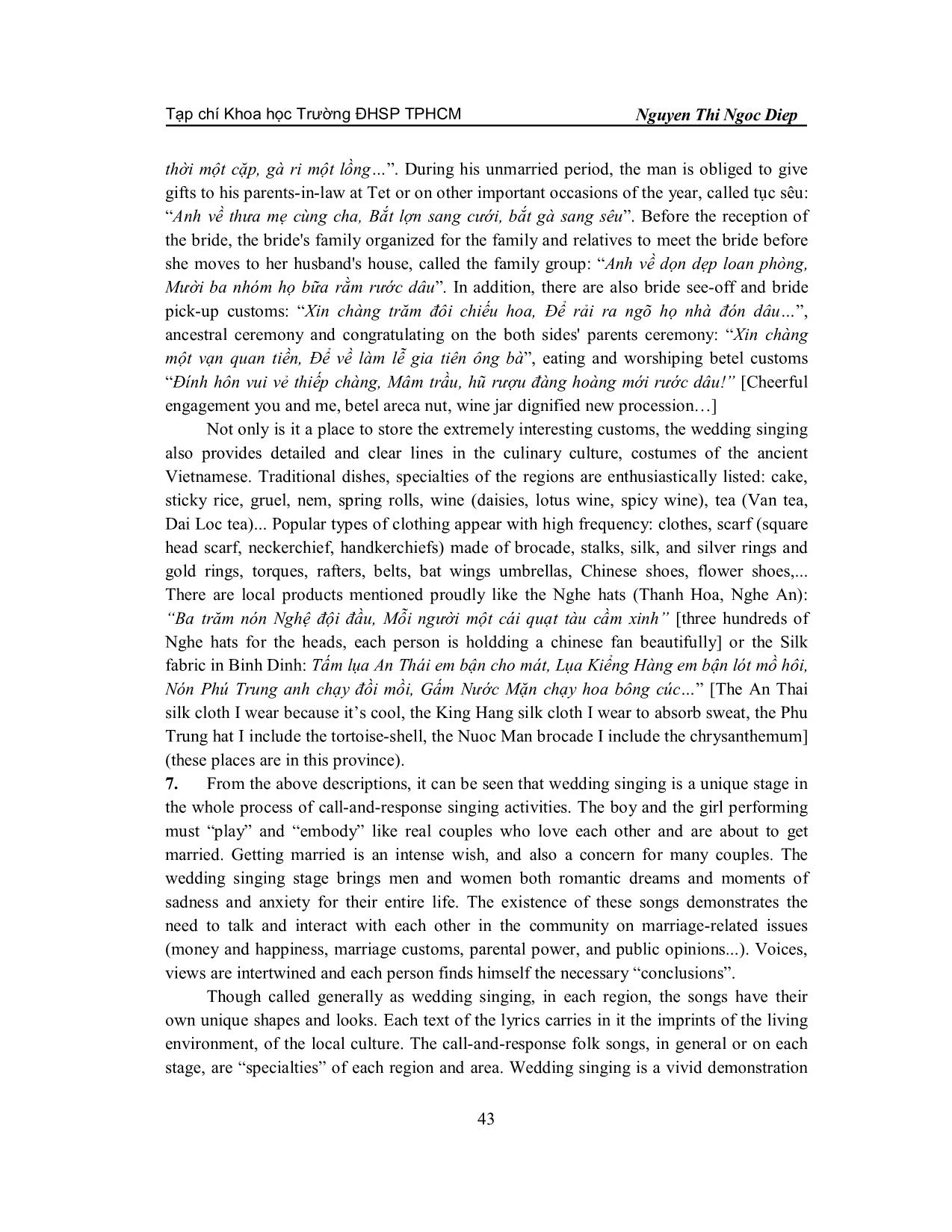
Trang 9
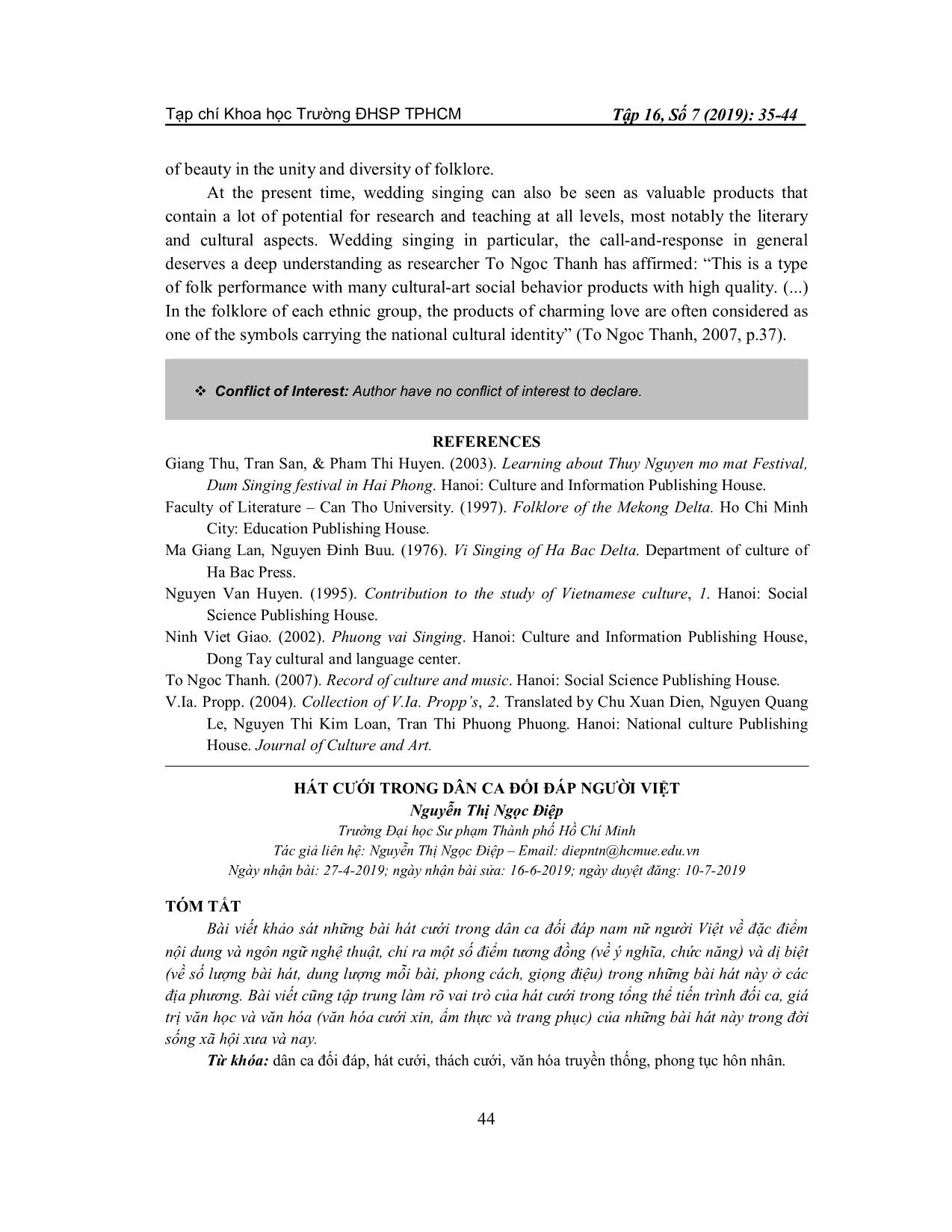
Trang 10
Tóm tắt nội dung tài liệu: Wedding singing in call-and-response folk song of Vietnamese people
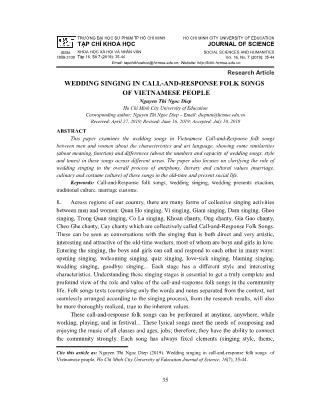
TRƯỜNG ĐẠI HỌC SƯ PHẠM TP HỒ CHÍ MINH HO CHI MINH CITY UNIVERSITY OF EDUCATION TẠP CHÍ KHOA HỌC JOURNAL OF SCIENCE ISSN: KHOA HỌC XÃ HỘI VÀ NHÂN VĂN SOCIAL SCIENCES AND HUMANITIES 1859-3100 Tập 16, Số 7 (2019): 35-44 Vol. 16, No. 7 (2019): 35-44 Email: tapchikhoahoc@hcmue.edu.vn; Website: Research Article WEDDING SINGING IN CALL-AND-RESPONSE FOLK SONGS* OF VIETNAMESE PEOPLE Nguyen Thi Ngoc Diep Ho Chi Minh City University of Education Corresponding author: Nguyen Thi Ngoc Diep – Email: diepntn@hcmue.edu.vn Received: April 27, 2019; Revised: June 16, 2019; Accepted: July 10, 2019 ABSTRACT This paper examines the wedding songs in Vietnamese Call-and-Response folk songs between men and women about the characteristics and art language, showing some similarities (about meaning, function) and differences (about the numbers and capacity of wedding songs, style and tones) in these songs across different areas. The paper also focuses on clarifying the role of wedding singing in the overall process of antiphony, literary and cultural values (marriage, culinary and costume culture) of these songs in the old-time and present social life. Keywords: Call-and-Response folk songs, wedding singing, wedding presents exaction, traditional culture, marriage customs. 1. Across regions of our country, there are many forms of collective singing activities between men and women: Quan Ho singing, Vi singing, Giam singing, Dam singing, Gheo singing, Trong Quan singing, Co La singing, Khoan chanty, Ong chanty, Gia Gao chanty, Cheo Ghe chanty, Cay chanty which are collectively called Call-and-Response Folk Songs. These can be seen as conversations with the singing that is both direct and very artistic, interesting and attractive of the old-time workers, most of whom are boys and girls in love. Entering the singing, the boys and girls can call and respond to each other in many ways: opening singing, welcoming singing, quiz singing, love-sick singing, blaming singing, wedding singing, goodbye singing... Each stage has a different style and interesting characteristics. Understanding these singing stages is essential to get a truly complete and profound view of the role and value of the call-and-response folk songs in the community life. Folk songs texts (comprising only the words and notes separated from the context, not seamlessly arranged according to the singing process), from the research results, will also be more thoroughly realized, true to the inherent values. These call-and-response folk songs can be performed at anytime, anywhere, while working, playing, and in festival... These lyrical songs meet the needs of composing and enjoying the music of all classes and ages, jobs; therefore, they have the ability to connect the community strongly. Each song has always fixed elements (singing style, theme, Cite this article as: Nguyen Thi Ngoc Diep (2019). Wedding singing in call-and-response folk songs* of Vietnamese people. Ho Chi Minh City University of Education Journal of Science, 16(7), 35-44. 35 Tạp chí Khoa học Trường ĐHSP TPHCM Tập 16, Số 7 (2019): 35-44 content... predetermined) and not fixed (singers, listeners, places, times, situations...), that is why the progress is often unduplicated. As the context of the performance changes, the verses are also used creatively to create a concordance. No singings are the same. This is the appeal of the call-and-response folk songs. The verses are both formal and creative. The voices of the community and the performers are harmoniously combined. In this living space, everyone feels “living” fully and completelywith their feelings, dreams and aspirations. Therefore, when “Trai thanh tân sánh gái mĩ miều” [The gentelman meets the beautiful lady], then “Trăm gươm kề cổ quyết liều cùng chơi” [Even when hundreds of swords are near the neck, they’re still nothing]. They want to “burn out” their best to “Hát cho lở đất long trời, Cho đời biết mặt, cho người biết tên “[Sing to the shattering earth and sky, so that the world knows our faces and names], as to meet each other it is not easy at all “Ở nhà nghe tiếng hò khoan, Trốn cha trốn mẹ băng ngàn tới đây” [I hear some shanty so I leave my family to be here]. They call and respond all-night endlessly because of the magic of the voices, of the words “Em nghe anh bỏ giọng trầm, Hồn xiêu phách lạc, vàng cầm em cũng buông” [When I hear your bass tone, I even drop the gold I’m holding] The process of a singing usually consists of the following forms: 1) The opening singing form comprising opening singing, greeting singing, asking after singing, promise singing, inviting singing, 2) The challenge singing Form comprising quizzing singing, exchanging singing, illustrative singing, catching singing; 3) The xe kết singing Form comprising longing singing, letter singing, promise singing, oath singing, complaining singing ... ng loan, Bốn chiếc tàu đồng chở hai họ đưa sang, Đàn ông dù Ngô, khăn nhiễu, đàn bà nón Thượng chóp vàng, Còn bao nhiêu con nít, bận áo hàng sơ mi!” [Your parents asked me not to know, but I asked to go to gold for hundreds of trays, Hundreds of motorbikes, hundred pairs of motorbikes, I went to white horses, you sat in a retina, Four copper ships carrying them both, Men Although Wu, a towel, and the golden top hat, how many children, how many shirts are there!] and another shopping song in the Southern: “Anh thương em, anh sắm cho em bộ áo dài màu cà, màu huyết, Anh đây nói thiệt, chẳng phải nói càn, Anh đây sắm cho em một cây kiềng vàng chạm tòng chạm bá, một bộ cà rá có chạm cửu long hường, Anh sắm cho em áo túi đủ màu, lụa Hà Đông, lục soạn” [I love you, I shop for you a long, dark-colored ao dai, I'm serious, I don't have to say anything, I buy for you a gold-rimmed tree with a touch, a set of curls with a touch of grace. I buy for you a full-color pocket shirt, Ha Dong silk]. Wedding singing generally prefers the listed description to meet the purpose of exactingwedding presents, offering wedding presents, shopping... For the Northern, this method is used at a higher frequency than Central and South Vietnam due to the rhetoric, exaggerated dominating most of the singing stages. The old-time composers were poor farmers who had to work hard all year round but still underfed; however, on immersing on the song, they create a space for their imagination to weave a affluent life. From the inquiring singing (introducing the rich and successful family condition) to betel offering singing, water offering singing, call-on invitation (delicious, unique food; luxurious and 40 Tạp chí Khoa học Trường ĐHSP TPHCM Nguyen Thi Ngoc Diep expensive containing boxes; skyscrapters) and singing wedding (noble, rare and precious; beautiful and valuable furniture)... all are consistent in a common style. Perhaps when they were immersed in singing activities, they wanted to get out of their daily life and dreams to relieve the pressure of making ends meet. The girls not only dream of a lavish wedding ceremony but also wish to receive respects: “Chàng về nhắn nhủ mẹ cha, Mua tre tiện đốt, làm nhà ở riêng, Chàng về nhắn nhủ láng giềng, Quét cổng, quét ngõ, ra giêng ta về” [He reminded his mother and father, Buy bamboo to burn, build houses separately, He reminded neighbors, Sweeping the gate, sweeping the lane, going back to my home...”], the procession of the bride has the elephant leading, the horse following, people holding the fan to cover the head, and servants. Wedding singing in Central and Southern Vietnam, on the contrary, carries the clear resonance of daily life. The number of songs referring to the simple wedding ceremonies, simple offerings occupy the majority. What they concern about the most is not the material value but the obedience to the rituals: “Anh đi cho em một lễ thỉnh kì, Heo thời một cặp, gà ri một lồng” [You went to me for a special occasion, Pig in a pair, a chicken in a cage], “Người ta giàu thì đầu heo nọng thịt, Hai đứa mình nghèo cặp vịt đôi bông” [People are rich when they have a pig's head, we are poor with a couple of ducks and ear rings] Thus, the difference lies not only in the quantity and capacity but also in the distinct color, style and tones of each region, etc. The Northern region is a land of cultural traditions, long-established rituals that the singing is built on that basis. Call-and-response singing activities are often a combination of many singing stages and a clear form. Therefore, the common existence of wedding singing is natural. Moving to the south, the land with a new history of formation, the customs of marriage from the outskirts following the footsteps of immigrants bring in are also open, more compact and the call-and-response folk songs do not often follw the predetermined “lines” and had a more liberal nature, so the wedding songs account for a small part and the content dóe not put a burden on the wedding pesents exacting and offering. It seems that wedding songs here are for poverty, but that is the money poverty, not ritual or gratitude poverty. 5. On overall, call-and-response folk songs in general and wedding singing in particular are the full and vivid expressions of the inner world of the old-time people with hopes, worries, joys and sadness... This is really the “self-singing”, “self-talk” of the male and female youth before their marriage threshold. Singing activities create conditions for each individual to be connected to the community, raise their voices, and meet the harmonious souls. Facing each other and the crowd of attendees, they seem to be not hesitant singing about what seem to be their private things, because that is their own personalities (affection, creativity) and the commonplace of the community (what is inherent) have joined together. This creates an attraction that is difficult to resist for both singers and listeners, forming interesting “playgrounds” and as a result, wedding songs become more and more rich and unique. 41 Tạp chí Khoa học Trường ĐHSP TPHCM Tập 16, Số 7 (2019): 35-44 Through the “long list” with the high requirements of the number and quality of offerings with the listing manipulation in a humorous tone, we can see somewhat critical attitude of the old-time workers toward the exacting wedding presents. Some statements of both sides have a direct mention of this depraved custom. The female side themselves find it unnecessary: “Em là thân phận nữ nhi, Thầy mẹ thách cưới làm chi bẽ bàng”. The male said: “Anh là con trai học trò, Em thách cưới thế anh lo thế nào” [I am a part of the female child, the mother and father challenge the wedding to be humiliating...; I am a son of the student, you challenge that wedding, how am I...]. A free marriage, unconstrained by the concept of “suitable alliance”, not requiring high-class offerings as a sale, without “exaction” and “bargaining”... is really an aspiration of the couples at that time. Talking about marriage, for poor workers, worries and lament are unavoidable. Wedding singing reflects closely, honestly and these feelings: “Cưới em anh nghĩ cũng lo, Con lợn chẳng có, con bò thì không” [If I marry you, I think it is also worrying. The pig does not have it, the cow does not]. Besides, the dream of a wedding that is full, a life without worries is also expressed quite clearly. The reality of the daily hardship and the hard living earning couldn't eliminate their creative spirit, sense of humor, inspiration and enthusiasm. It can be said that wedding singing has contributed to bringing a close look on life and people in a passed historical period. 6. From the cultural perspective, the wedding singing provides the readers with more insights of the customs of old-day marriage. “We are both poor”. When shopping for newlyweds..., the customs are always mentioned naturally and vividly in a significant amount, lasting from the time when the two families intend to hold a wedding until it is completed with a wedding. Beginning is a matchmaking procedure. The girls often tell their lovers “Thương em đừng dỗ đừng dành, Cậy mai dong tới nói, cha mẹ đành em ưng” [Love me, don't coax, don't talk, Say it to me, my parents agree I agree]. They play such an important role that they are an indispensable guest on the happy day, even at very poor weddings: “Phía bên anh đừng mời chi đông, Nội cha với mẹ, vợ chồng ông mai” [His side did not invite the eastern branch, Grandfather father with his mother, his wife tomorrow...]. The man who wants to get married must pay a sum of money or gifts as prescribed to the village so that the marriage is recognized by everyone. This is also a great challenge for the poor. Wedding singing has refered to this custom many times: “Anh về thưa mẹ cùng cha, Bắt lợn sang cưới, bắt gà sang cheo” [You return to your mother and father, Catching pigs to marry, catching chickens to ask]. The process of marriage must go through six ceremonies, including rite of asking names and asking ritual. After getting the consent of the girl's family, the son's family brings betel and areca, and officially mentions the issue. It is a rite of asking names. From here on, it is considered that the girl has found a new place: “Anh về thưa với ông bà, Buồng cau chai rượu để mà vấn danh”. Asking ritual is a ceremony where the man's family confirms that he would definitely marry the girl and asks for a suitable day to arrange a wedding: “Anh đi cho em một lễ thỉnh kì, Heo 42 Tạp chí Khoa học Trường ĐHSP TPHCM Nguyen Thi Ngoc Diep thời một cặp, gà ri một lồng”. During his unmarried period, the man is obliged to give gifts to his parents-in-law at Tet or on other important occasions of the year, called tục sêu: “Anh về thưa mẹ cùng cha, Bắt lợn sang cưới, bắt gà sang sêu”. Before the reception of the bride, the bride's family organized for the family and relatives to meet the bride before she moves to her husband's house, called the family group: “Anh về dọn dẹp loan phòng, Mười ba nhóm họ bữa rằm rước dâu”. In addition, there are also bride see-off and bride pick-up customs: “Xin chàng trăm đôi chiếu hoa, Để rải ra ngõ họ nhà đón dâu”, ancestral ceremony and congratulating on the both sides' parents ceremony: “Xin chàng một vạn quan tiền, Để về làm lễ gia tiên ông bà”, eating and worshiping betel customs “Đính hôn vui vẻ thiếp chàng, Mâm trầu, hũ rượu đàng hoàng mới rước dâu!” [Cheerful engagement you and me, betel areca nut, wine jar dignified new procession] Not only is it a place to store the extremely interesting customs, the wedding singing also provides detailed and clear lines in the culinary culture, costumes of the ancient Vietnamese. Traditional dishes, specialties of the regions are enthusiastically listed: cake, sticky rice, gruel, nem, spring rolls, wine (daisies, lotus wine, spicy wine), tea (Van tea, Dai Loc tea)... Popular types of clothing appear with high frequency: clothes, scarf (square head scarf, neckerchief, handkerchiefs) made of brocade, stalks, silk, and silver rings and gold rings, torques, rafters, belts, bat wings umbrellas, Chinese shoes, flower shoes,... There are local products mentioned proudly like the Nghe hats (Thanh Hoa, Nghe An): “Ba trăm nón Nghệ đội đầu, Mỗi người một cái quạt tàu cầm xinh” [three hundreds of Nghe hats for the heads, each person is holdding a chinese fan beautifully] or the Silk fabric in Binh Dinh: Tấm lụa An Thái em bận cho mát, Lụa Kiểng Hàng em bận lót mồ hôi, Nón Phú Trung anh chạy đồi mồi, Gấm Nước Mặn chạy hoa bông cúc” [The An Thai silk cloth I wear because it’s cool, the King Hang silk cloth I wear to absorb sweat, the Phu Trung hat I include the tortoise-shell, the Nuoc Man brocade I include the chrysanthemum] (these places are in this province). 7. From the above descriptions, it can be seen that wedding singing is a unique stage in the whole process of call-and-response singing activities. The boy and the girl performing must “play” and “embody” like real couples who love each other and are about to get married. Getting married is an intense wish, and also a concern for many couples. The wedding singing stage brings men and women both romantic dreams and moments of sadness and anxiety for their entire life. The existence of these songs demonstrates the need to talk and interact with each other in the community on marriage-related issues (money and happiness, marriage customs, parental power, and public opinions...). Voices, views are intertwined and each person finds himself the necessary “conclusions”. Though called generally as wedding singing, in each region, the songs have their own unique shapes and looks. Each text of the lyrics carries in it the imprints of the living environment, of the local culture. The call-and-response folk songs, in general or on each stage, are “specialties” of each region and area. Wedding singing is a vivid demonstration 43 Tạp chí Khoa học Trường ĐHSP TPHCM Tập 16, Số 7 (2019): 35-44 of beauty in the unity and diversity of folklore. At the present time, wedding singing can also be seen as valuable products that contain a lot of potential for research and teaching at all levels, most notably the literary and cultural aspects. Wedding singing in particular, the call-and-response in general deserves a deep understanding as researcher To Ngoc Thanh has affirmed: “This is a type of folk performance with many cultural-art social behavior products with high quality. (...) In the folklore of each ethnic group, the products of charming love are often considered as one of the symbols carrying the national cultural identity” (To Ngoc Thanh, 2007, p.37). Conflict of Interest: Author have no conflict of interest to declare. REFERENCES Giang Thu, Tran San, & Pham Thi Huyen. (2003). Learning about Thuy Nguyen mo mat Festival, Dum Singing festival in Hai Phong. Hanoi: Culture and Information Publishing House. Faculty of Literature – Can Tho University. (1997). Folklore of the Mekong Delta. Ho Chi Minh City: Education Publishing House. Ma Giang Lan, Nguyen Đinh Buu. (1976). Vi Singing of Ha Bac Delta. Department of culture of Ha Bac Press. Nguyen Van Huyen. (1995). Contribution to the study of Vietnamese culture, 1. Hanoi: Social Science Publishing House. Ninh Viet Giao. (2002). Phuong vai Singing. Hanoi: Culture and Information Publishing House, Dong Tay cultural and language center. To Ngoc Thanh. (2007). Record of culture and music. Hanoi: Social Science Publishing House. V.Ia. Propp. (2004). Collection of V.Ia. Propp’s, 2. Translated by Chu Xuan Dien, Nguyen Quang Le, Nguyen Thi Kim Loan, Tran Thi Phuong Phuong. Hanoi: National culture Publishing House. Journal of Culture and Art. HÁT CƯỚI TRONG DÂN CA ĐỐI ĐÁP NGƯỜI VIỆT Nguyễn Thị Ngọc Điệp Trường Đại học Sư phạm Thành phố Hồ Chí Minh Tác giả liên hệ: Nguyễn Thị Ngọc Điệp – Email: diepntn@hcmue.edu.vn Ngày nhận bài: 27-4-2019; ngày nhận bài sửa: 16-6-2019; ngày duyệt đăng: 10-7-2019 TÓM TẮT Bài viết khảo sát những bài hát cưới trong dân ca đối đáp nam nữ người Việt về đặc điểm nội dung và ngôn ngữ nghệ thuật, chỉ ra một số điểm tương đồng (về ý nghĩa, chức năng) và dị biệt (về số lượng bài hát, dung lượng mỗi bài, phong cách, giọng điệu) trong những bài hát này ở các địa phương. Bài viết cũng tập trung làm rõ vai trò của hát cưới trong tổng thể tiến trình đối ca, giá trị văn học và văn hóa (văn hóa cưới xin, ẩm thực và trang phục) của những bài hát này trong đời sống xã hội xưa và nay. Từ khóa: dân ca đối đáp, hát cưới, thách cưới, văn hóa truyền thống, phong tục hôn nhân. 44
File đính kèm:
 wedding_singing_in_call_and_response_folk_song_of_vietnamese.pdf
wedding_singing_in_call_and_response_folk_song_of_vietnamese.pdf

